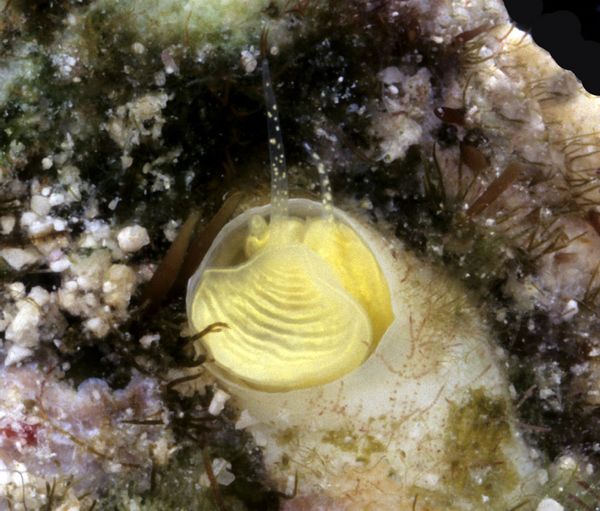According to a recent study in the scientific journal PeerJ, a bright yellow snail unlike any other discovered species lives in the Florida Keys. It's official name is Cayo margarita, which refers both to the type of small, low island where it lives and the bright yellow alcoholic drink that it so closely resembles.
It may not be surprising the snail was given this moniker because the scientists who named it are admirers of tropical rock musician Jimmy Buffett and his hit 1977 song "Margaritaville." Indeed, the lead author of the study is a self-professed "parrothead."
 An underwater closeup of the Keys Margarita Snail, Cayo margarita (new species) in the coral reef of the Florida Keys. Note the two long tentacles, used by the snail to spread the mucus net for feeding. (Photo by R. Bieler)
An underwater closeup of the Keys Margarita Snail, Cayo margarita (new species) in the coral reef of the Florida Keys. Note the two long tentacles, used by the snail to spread the mucus net for feeding. (Photo by R. Bieler)
"So far, this particular snail species is only known from the Florida Keys and the luminous yellow color looked 'citrusy' to me from the first time I saw them underwater while scuba diving," Rüdiger Bieler, PhD, Curator of Zoology/Invertebrates at the Field Museum of Natural History's Negaunee Integrative Research Center, told Salon by email. "Its peculiar coloration led to labeling the Keys species as 'margarita-colored' in the lab — alluding to the regional signature drink and Jimmy Buffett’s music. The name then stuck."
"And, yes, I freely admit to being a parrothead," Bieler added.
Although the Cayo margarita is distantly related to the more familiar land-bound snails, they are different in at least one crucial respect: Their lifestyle makes even the pokiest land snail seem like a veritable speed demon. That's because the margarita snail fuses its shell to a hard surface when it's young, and then stays there for the rest of its life. Once the snail cements its shell to the substrate, it forms an irregular tube around their bodies, where the snail then hunts for plankton and other food sources with a mucus web. But this isn't the only quality that makes Cayo margarita so unique.
"The most distinctive feature of this species is the luminous coloration that we have not seen in any other species," Bieler explained. Moreover, because so-called worm snails like the Cayo margarita are unusual among snails in never moving, "it means having to invent completely new ways of eating, reproducing and defending yourself. In their evolution, this has led to very interesting anatomical and behavioral innovations," Bieler said.
Both in the wild and in his laboratory, Bieler has seen Cayo margarita snails that "have long tentacles that are connected to a mucus gland in the animal’s muscular foot and these tentacles can release mucus threads that combine into a spider-like web to trap plankton and floating particles from the water column." When the animal has caught its fill, it eats the entire mucus web and regurgitates the valuable mucus that it will need for future food gathering.
"Small-bodied invertebrates in particular might vanish before we even had an opportunity to recognize and describe them. "
These dining tricks may seem merely showy, but they allow this worm-snail to stand out when it matters most.
"These animals are directly competing with the surrounding coral polyps for food but use a very different technique for capturing it," Bieler pointed out.
Want more health and science stories in your inbox? Subscribe to Salon's weekly newsletter Lab Notes.
The snail also belongs to a new genus, distinguishing it from every other worm-snail known to scientists (except for one other found by these scientists). "We did not expect the need to describe a new genus (Cayo) for them," Bieler said. "Prior to this study, we assumed all worm-snails that lack a protective lid (and thus display a more-or-less colorful 'face' at the shell opening) belonged to a single genus, Thylacodes, like the new species we named for Bermuda in our article."
After the researchers performed DNA sequencing on the new snail species, however, they realized that this snail had evolved in an entirely different way. "This group represents a separate case of worm-snails having lost the operculum [a plate that closes the aperture of a mollusk's shell] and developed other means of protection from predation," Bierler said.
Unfortunately for C. margarita, even the world's strongest operculum could not protect them from their biggest threat: human civilization. As Bieler pointed out, this species is only known to exist in the Florida Keys, which is a popular tourist destination. The Florida Keys is also very biologically diverse, and as such there are countless animal species there interacting in fascinating ecosystems that people may never even know about.
"Finding such new species in a popular tourist area that has been comparatively well studied points out that there is much undiscovered biological diversity under our very noses — small-bodied invertebrates in particular might vanish before we even had an opportunity to recognize and describe them," Bieler said. "Biologically, these are very interesting and still-understudied organisms — we are just learning of the defensive properties of the mucus and are realizing that these newly discovered species have previously unknown morphological and biochemical features."
We need your help to stay independent
He added that it is especially exciting that this group "represents a second case of 'inventing' colorful bodies is leading to more general questions about the evolution of warning coloration and predator-prey interactions."
The only other worm-snail species that can do this is the related species Cayo galbinus, which was discovered in Belize. It is also colored like an alcoholic beverage — in this case, lime-green.
“Initially, when I saw the lime-green one and the lemon-yellow one, I figured they were the same species,” Bieler said in a statement. “But when we sequenced their DNA, they were very different.”
Read more
about snails



Shares